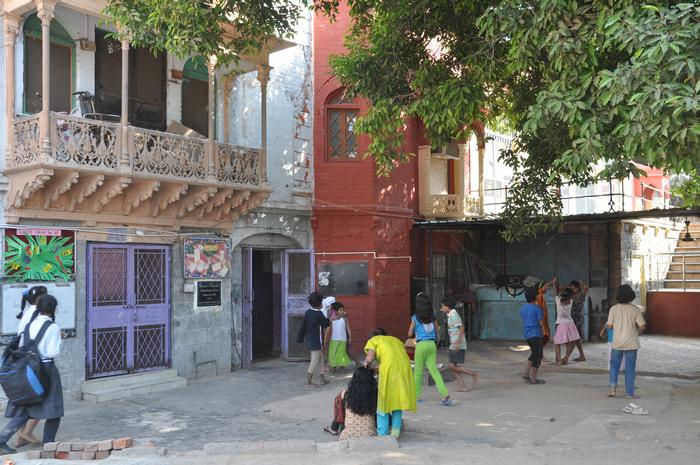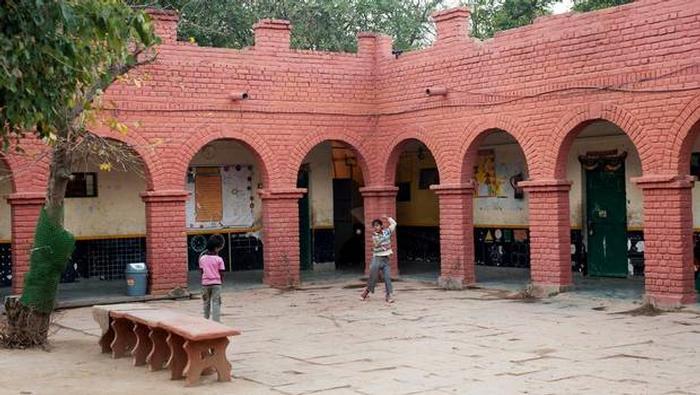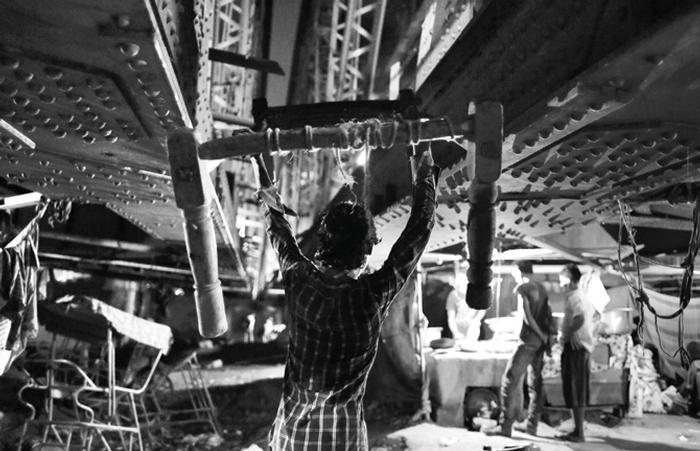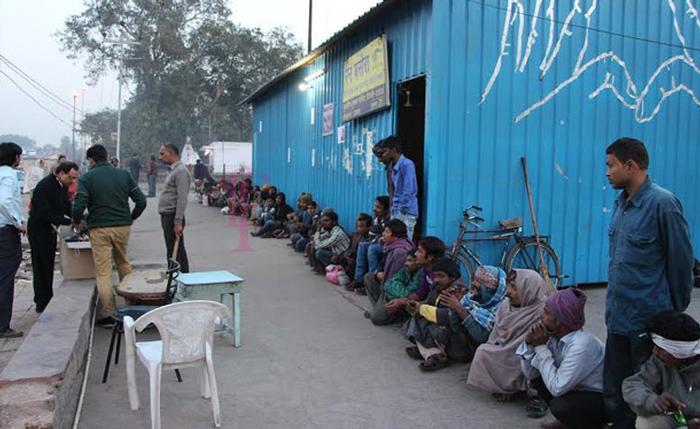[ID:1968] Confronting Homelessness Through CommunityIndia “Have you ever wondered why people sleep on (road) dividers during the summer? When cars pass by, the gush of wind prevents mosquitoes from biting. So if you wish to save yourself from dengue-malaria in Delhi, sleep on dividers.”[1]
The opening quote from the documentary ‘Cities of Sleep’ proffers a startlingly realistic image of the homeless in Delhi - an image of an entire section of society that for the large part is simply ignored by the rest of the city - an ignorance not only limited to the people, but one that also extends to the infrastructure of the city.
There are, however, a few initiatives being taken by a number of organisations to help house the homeless. To better understand the issue at hand, we visited a number of shelters across Delhi.
“I want to be a doctor when I grow up. Then a dancer.” Nine year old Saida’s face broke into a grin, her eyes alight with anticipation. Until two years ago, she used to spend her days begging for money on the streets and her nights sleeping in a makeshift tent on the pavement. Her father, a rickshaw puller, decided to send her to the Kilkari Rainbow Home for Girls to give her hope for a better future.
The girls at Kilkari live together in a charming old building in the heart of the city. Set up and managed by Aman Biradari, an NGO, a number of girls like Saida live together at the home – some sent there by their parents, others abandoned and sent there by court order. The girls attend a government school behind Kilkari; afternoons and evenings are spent playing together. Sometimes, in the court that adjoins the building, they put up performances; music and dance add colour to an otherwise lifeless space.
Meals are eaten together in a large room; the simple act of sitting together and eating makes the “not-so-tasty food seem bearable”. Although the sleeping arrangement is cramped (mattresses laid side by side in two large rooms), the hundred-odd girls prefer the comfort of sleeping together. When asked if she would like her own room, Saida told us about how scared she would feel sleeping alone, and how the presence of her friends made her feel safer and more secure.
Kilkari thus is more than just a “shelter” for the girls - it is a home. The girls not only sleep together – they live together, celebrate festivals together and work together. Despite the architectural and spacial limitations imposed on the home, it creates an environment that offers the girls a feeling of security, community, and belonging.
The Delhi Urban Shelter Improvement Board (DUSIB) started constructing night shelters (or Rain Baseras as they are known) a few years ago. As dusk approaches, wiry figures wrapped up in shawls and tattered sweaters walk down the pavements, their numbers increasing as the sky darkens. One evening, we hoisted our backpacks and followed one such group to the DUSIB night shelters near the Inter-State Bus Terminal (ISBT).
We soon came to a large patch of land occupied by the night shelters. As we watched, men bought themselves dinner at a nearby stall, and slowly started settling down in one of the four shelters - two large canvas tents and two corrugated tin huts.
The shelters themselves were cramped and poorly constructed - the tin huts were capped with sloping roofs; a large gap existed between the walls and roof, with wire mesh serving to keep the mosquitoes out. Inside, men slept side by side on the floor, forming two separate rows along each side of the room. The huts accommodated around eighty people; the tents accommodated fifty. A set of five portable toilets catered to all four shelters - an approximate ratio of seventy-two people to a toilet.
Twenty-six year old Bikram told us about his experiences at the shelters. A part-time labourer by day, he travels ten kilometres everyday to come to the ISBT Rain Baseras. For him, the cramped sleeping conditions of the Rain Basera were uncomfortable. Security, or the lack thereof, being the biggest issue at such shelters, the inhabitants have to be extremely careful with their belongings. When asked about changes that could be made to the existing shelters, he spoke of a facility to lock and store belongings, as well as a way of demarcating space within the shelter, so that people could cluster together in smaller groups, forming their own mini-communities within the larger, not-so-hospitable space - a far cry from the current situation, in which one is forced to sleep cheek-by-jowl next to complete strangers.
As we were walking through Kashmere Gate in search of Kilkari, we came across an interesting discovery - two “re used” Rain Baseras within a kilometre of one another. Set up jointly by DUSIB and Prayas, an NGO, both had been Municipal Corporation community centers before being converted into night shelters. The first of these shelters housed around 300 men, the second being exclusively for juveniles – boys below the age of eighteen without a home.
Inside, the layout was very similar to that of the DUSIB Rain Baseras; the only difference (other than the permanence of the structure), was the presence of adequate bathrooms with running piped water.
While researching further however, we chanced upon an anomaly. In certain parts of Delhi, namely Meena Bazar (a busy market by day), and Loha Pul (an old iron bridge over the river Yamuna), exist ‘sleeping communities’. ‘Cities of Sleep’, a documentary by filmmaker Shaunak Sen, chronicles the two shelters.
Ranjit-bhai, as he is known, is the man behind the Loha Pul sleeping community. He used to be a rickshaw driver, working through the day and spending the night in Rain Baseras and other shelters. On some occasions, he would watch a film at the nearby cinema, only to fall asleep in the comfort of the cinema hall. For him, the best sleep he ever had was right there in that cinema. Today, at the shelter he runs under the Loha Pul, he charges five rupees (0.08 USD) for six hours of sleep or three films.
In a makeshift tent which uses the old iron bridge above it to protect it from the elements, labourers, rickshaw drivers and other daily-wage workers watch films every night on a large television, most of them dropping off to sleep while the films are on.
However the merit of the Loha Pul shelter does not only lie in providing entertainment to it’s inhabitants. In addition to simply providing shelter for the night, it offers an escape for those who visit it. As soon as a person enters, he stops being a rickshaw puller or a labourer. He becomes part of a community - a community that watches films together and sleeps together. For these people, it is this shelter that is the one constant in their lives. Given the nature of their occupations, each day for them is like starting over. Each day they set out, uncertain as to where or when they will earn their keep. In the evening, however, they all return to the same shelter for the night.
The Kilkari Rainbow Home, although limited to girls of a certain age, appealed to us because of the adaptive reuse of a century-old building. We also identified with the feeling of belonging the home provides for them.
The DUSIB Rain Baseras were in stark contrast to Kilkari - spartan, bleak and unwelcoming. In addition, there were no shelters for women and children nearby. The closest women’s shelter was across the river in an entirely different part of the city. A homeless family, then, has no choice but to let itself be split up for the night.
The “re-used” Rain Baseras had absolutely no architectural addition to the original building. They were simply stripped out buildings, which, while being efficient shelters, were not “communities”.
This left us slightly vexed. The shelter in newly constructed brick and mortar, with functional amenities, far more permanent than the others, was possibly the one that did the least for fostering a feeling of community within people.
It was then that we started to understand the importance of the Loha Pul shelter, and the meaning of the word “community”. At the Loha Pul community, the people were part of the shelter, instead of just being inhabitants. Additionally, unlike the Rain Baseras set up by the government, the inhabitants of Loha Pul had the option of storing their belongings in different nooks and crannies under the bridge. As a result, instead of being an alien space used solely for sleeping, the Loha Pul shelter is a personal, intimate space to which they come back each night.
As architects, we often tend to associate the word “shelter” with a tangible, built, permanent structure. However the sleeping community was a living, thriving example of a community without one – the only permanent part about it being the bridge itself.
In our essay proposal, we said that the role of the architect today lies in being able to identify and empathise with the needs of the homeless and to refrain from design solutions that are solely conceptual and disconnected from the end user. As students of architecture, talking to members of homeless communities left us with several opinions on the role of the architect. What, then, from an architectural point of view, constitutes an efficient solution to providing shelter to the homeless?
The above question leads to another - what do the homeless really need?
There are two parts to the answer.
The first is fairly straightforward and deals with the tangible, that is, some form of shelter.
The second part is more complex and deals with the intangible - a sense of belonging and security.
The conundrum lies in the second part of the answer; how do we as architects help to provide that intangible, empathetic extra?
Kilkari was one example of the adaptive re-use of a building for the homeless. However, why should the concept of adaptive re-use have to be limited only to buildings? As soon as we expand it to include adaptive re-use of infrastructure, it provides us with a multitude of design solutions. The Loha Pul shelter is an example of the adaptive re-use of public infrastructure. Below a functioning vehicular bridge, it manages to make use of the existing bridge for shelter and structural support without causing any disturbance to the city.
There is clearly a need to make public infrastructure homeless-friendly. There are a number of opportunities available for this very purpose. The area under flyovers, for example, is greatly ignored. Most of these areas are 'beautifully' landscaped, with plants unsuitable for the weather and paved paths that no one uses. The benches at bus stops in Delhi have raised partitions between the seats, rendering it impossible for anybody to sleep across. It almost seems like the city is engineered against the homeless.
In such a situation, the architect must intervene by spelling out approaches to inclusive design, based on principles of an egalitarian society. With a few simple additions to already existing infrastructure, a greater number of homeless people can be accommodated, while still striving to uphold a certain quality of life. Imagine a city where public infrastructure is used at night by the homeless; the designs could accommodate families or groups of five-six people. If these designs are implemented at regular intervals, they will also not have to walk several kilometers in search of shelter. The Times of India recently[2] carried an article about how many homeless refused to be shifted into government night shelters for fear of losing their ‘place’ on the pavement.
However, simply making benches flat or the area under flyovers habitable is not enough. As we have seen through the example of the “re-used” Rain Baseras, simply re-using a building does not guarantee a comfortable experience for the homeless.
The Loha Pul and Meena Bazaar communities demonstrate that the user is most adept at creating self-sustaining ecosystems for themselves, much more so than a disconnected provider. To be of meaningful assistance, the architect could offer improvement to a self-functioning ecosystem, by studying its faults and suggesting solutions. The Loha Pul Community, too, is not without it’s faults. As a result of it’s proximity to the river, it often has to be inconveniently evacuated when the area floods. The installation of an embankment or other such simple design solutions is what the architect could offer, rather than an esoteric, solely conceptual design.
Another question presented itself to us in our process of thought. Does the architect’s role stop at the design stage, or do they have a role of providing more to society?
In a recent inspiring incident, renowned architect Laurie Baker refused an invitation for a luncheon to the Prime Minister of India’s house. In his response, he requested that the funds for the luncheon be transferred to his project on low-income housing.
Technically speaking, the idea of adaptive re-use is challenged by government policies and bureaucratic ordeals. Many architects find it easier to have new buildings constructed rather than go through the process of auditing and spatially re-designing existing ones. The workers of Aman Biradari are not architects, but part of a social provision NGO, who have managed to secure homes across the city to use as shelters.
This is where the role of the architect merges with that of the individual. It takes a sensitive architect to design with empathy, but a determined individual to exemplify and lobby for social change. Often an under-estimated act, we found that many projects outlined for social change within the city have stalled mid-way because nobody was willing to carry out tedious appeal work.
Volunteering to work with NGOs such as Aman Biradari, Aashray Adhikar Abhiyan and the like to provide their professional input is another way architects could involve themselves.
Most of us turn away from social problems for fear of how large and difficult they are. Apathy is easier than diving into a complex issue. Practically, adaptive re-use requires heavy paper-work and sensibilities in design. As undergraduate students, we tried to recognize these sensibilities and form some of our own. Kilkari and Loha Pul were communities within themselves due to the way their spaces are designed. Conflictingly, Rain Baseras only add to the problems of the homeless, with theft, drugs and alcohol being widely prevalent.
For a skilled architect, there are many design solutions to combat homelessness. The distinction is in understanding how useful these solutions are to the homeless, and what they could contribute to a larger socio-political sphere. The homeless in themselves are a community; their interactions are not limited by caste or religion.
Empathetic designs first require an individual engagement with the end-user and the problem. The architect is, after all, a thinking individual with a responsibility to provide dignity to humanity.
[1] ‘Cities of Sleep’. Shaunak Sen, 2015 [2] Times of India, January 24, 2016, Page 8
If you would like to contact this author, please send a request to info@berkeleyprize.org. |




